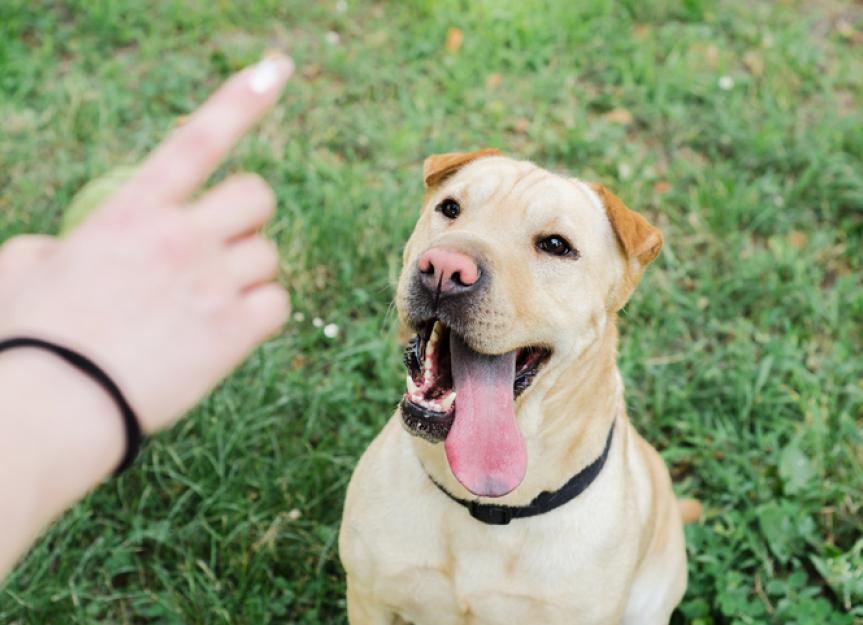
Sit: It’s the most basic cue in the dog training toolkit, so straightforward that some dogs seem prewired to do it. It doesn’t matter if you’re working with an 8-week-old puppy or an adult rescue—learning how to teach a dog to sit is the perfect place to begin your training journey.
How To Train a Dog to Sit
Follow these steps to master this useful training cue using a “capture” method.
1. Gather Your Supplies
The most important part of the training process—aside from an upbeat attitude—is dog treats, and lots of them. Before you begin, load up your pockets with small, extra special, soft treats.
While your dog might happily eat anything and everything, class time requires the good stuff. You can use small bits of hot dog or cheese, or store-bought treats like freeze-dried chicken or smelly salmon goodies.
Because you’ll be giving quite a few treats throughout class time, make sure they’re not too big. Aim for pinkie nail-size treats for petite pups, and thumbnail sizes for bigger dogs.
2. Choose a Location
Pick a familiar, quiet environment for your initial training sessions. Opt for a room where you regularly hang out together so your dog isn’t tempted to explore the surroundings instead of focusing on you.
Be aware of your body language as you begin the training process. Our dogs take in all of our communication, both verbal and nonverbal. Try to keep your body as neutral as possible when teaching a dog to sit.
3. Get Your Dog’s Attention
To begin, get your dog’s attention by making kissy noises or a quick whistle. Then move around the room and come to a stop when your dog is close to you.
If your pup jumps up, stay neutral and ignore the behavior that you don’t want, stepping aside if the jumping continues.
4. Wait for the Sit—Then Dole Out Rewards
After a few moments your dog will likely pause and then collapse into a sit. When that happens, mark the correct behavior with either a word like ‘Yup!’ or a clicker, then quickly follow up with a treat.
5. Repeat The Above Steps
Move around the room again, pause, and wait for your dog to move into a sit.
Again, ignore any jumpy behavior. It’s normal excitement and should decrease as your dog learns that it doesn’t work to get your attention.
Be quick to use your marker word, or clicker and treats to capture the moment your dog moves into a sit.
6. Add the Training Cue
After a few repetitions, your dog will start to figure out the connection between their behavior and the resulting treats and will move into a seated position more quickly. At this point, you can begin attaching the word “sit” to the behavior.
To do this, say “sit” right as your dog starts to sit, quickly marking the behavior with your word or clicker and following up with a treat. Doing this helps your dog learn to associate the cue word “sit” with the behavior they’re performing.
After a dozen or so repetitions, it’s time to test your pup. Move around the room, come to a stop, and then ask your dog to sit instead of waiting for them to assume the position. If your dog understands what the word means and moves into position, it’s a success!
If they falter, continue to practice saying “sit” when your dog starts to sit.
7. Try It in Different Places
Once your dog is reliably responding to the word “sit” in familiar spots around your house, try introducing it in environments with more distractions, like out in the yard or during a walk.
To a dog, a sit in the kitchen is different from a sit in a distracting environment, so don’t be surprised if your dog is slower to respond at first.
Remember to be generous with treats during the learning stage.
Tips for Teaching a Dog To Sit
-
Keep training sessions short. It’s tempting to keep working when things are going well, but it’s better for both of you to do a bunch of short sessions as opposed to one long, drawn-out session. You don’t want your dog getting bored by nonstop drills.
-
Never punish your dog. Punishment-based training techniques are outdated, painful, and unnecessary. Refrain from punishing your dog during this and all training exercises.
FAQs About How To Teach a Dog To Sit
How long does it take for a dog to learn to sit?
Sit is one of the speediest training cues to teach a dog, because it’s a natural and comfortable position for them. Most dogs, from puppies to seniors, can grasp the basic concept within one or two sessions, although total mastery in all environments can take longer.
What is the best age to teach a dog to sit?
Dogs are lifelong learners, which means that dogs of all ages, from puppies to seniors, can learn how to sit. New pups are often eager to learn and to please their human, so it may be easiest to start lessons when dogs are young.
What is the easiest way to teach a dog to sit?
The easiest method for teaching a dog to sit is using the capture method, in which the trainer waits for the dog to sit on their own and then “captures” the behavior by rewarding it with treats and praise.
In some cases, using a hand-luring gesture can aid the process, especially if a canine student seems distracted. The challenge with this technique is that some dogs can become dependent on seeing a hand signal, rather than listening for the cue.
Teaching a dog to sit using the capture technique ensures that the word “sit” is cemented to the behavior without requiring additional signals.



